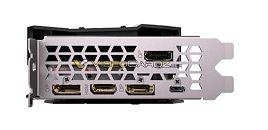- Joined
- Oct 9, 2007
- Messages
- 47,662 (7.43/day)
- Location
- Dublin, Ireland
| System Name | RBMK-1000 |
|---|---|
| Processor | AMD Ryzen 7 5700G |
| Motherboard | Gigabyte B550 AORUS Elite V2 |
| Cooling | DeepCool Gammax L240 V2 |
| Memory | 2x 16GB DDR4-3200 |
| Video Card(s) | Galax RTX 4070 Ti EX |
| Storage | Samsung 990 1TB |
| Display(s) | BenQ 1440p 60 Hz 27-inch |
| Case | Corsair Carbide 100R |
| Audio Device(s) | ASUS SupremeFX S1220A |
| Power Supply | Cooler Master MWE Gold 650W |
| Mouse | ASUS ROG Strix Impact |
| Keyboard | Gamdias Hermes E2 |
| Software | Windows 11 Pro |
With its GeForce "Maxwell" family, NVIDIA, riding on the multi-monitor fad, began equipping its graphics cards with up to three DisplayPort connectors, besides an HDMI, and optionally, a legacy DVI connector. Prior to that generation, AMD dabbled with equipping its cards with two mini-DisplayPorts, besides two DVI and an HDMI.
With the latest GeForce RTX "Turing" family, NVIDIA could push for the adoption of USB type-C connectors with DisplayPort wiring, and perhaps even USB-PD standards compliance, pushing up to 60 Watts of power from the same port. This USB+DP+Power connector is called VirtuaLink. This could make it easier for VR HMD manufacturers to design newer generations of their devices with a single USB type-C connection for display and audio input form the GPU, USB input from the system, and power. We reckon 60W is plenty of power for a VR HMD.

View at TechPowerUp Main Site
With the latest GeForce RTX "Turing" family, NVIDIA could push for the adoption of USB type-C connectors with DisplayPort wiring, and perhaps even USB-PD standards compliance, pushing up to 60 Watts of power from the same port. This USB+DP+Power connector is called VirtuaLink. This could make it easier for VR HMD manufacturers to design newer generations of their devices with a single USB type-C connection for display and audio input form the GPU, USB input from the system, and power. We reckon 60W is plenty of power for a VR HMD.

View at TechPowerUp Main Site






